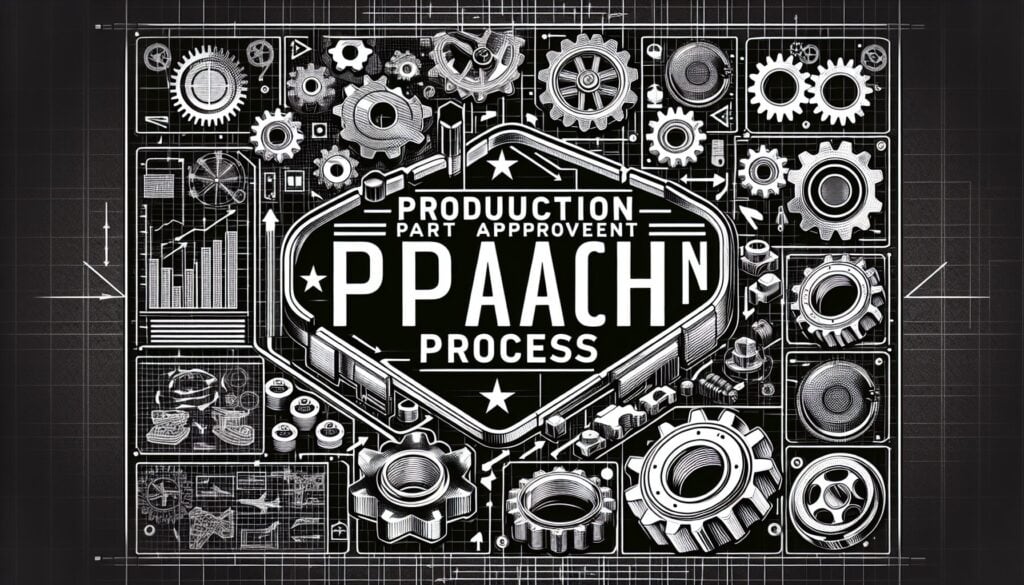Un proceso estandarizado en las industrias automovilística y aeroespacial (y otras) que garantiza que los proveedores puedan producir piezas que cumplan los requisitos de las especificaciones y el registro de diseño de ingeniería del cliente.
- Metodologías: Clientes y marketing, Ideación, Diseño de producto
PPAP (Proceso de aprobación de piezas de producción)

PPAP (Proceso de aprobación de piezas de producción)
- Planificación avanzada de la calidad del producto (APQP), Capacidad de proceso, Mejora de procesos, Proceso de aprobación de piezas de producción (PPAP), Seguro de calidad, Control de calidad, Gestión de calidad, Sistema de Gestión de Calidad (SGC), Poder del proveedor
Objetivo:
Cómo se utiliza:
- El proveedor compila un paquete de documentos y muestras (el paquete PPAP) que demuestra que su proceso de fabricación puede producir piezas que cumplen todos los requisitos. Este paquete se presenta al cliente para su aprobación antes de que comience la producción completa.
Ventajas
- Garantiza una comunicación clara de los requisitos entre el cliente y el proveedor; Verifica la comprensión y la capacidad del proveedor para cumplir los requisitos; Reduce los riesgos de piezas no conformes en la producción; Proporciona pruebas objetivas de capacidad de proceso.
Contras
- Los requisitos pueden ser complejos y variar de un cliente a otro. Cualquier cambio en el producto o el proceso suele requerir una nueva presentación, lo que aumenta la carga de trabajo.
Categorías:
- Fabricación, Calidad
Ideal para:
- Garantizar que los procesos de producción de los proveedores son capaces de producir de forma coherente piezas que cumplan todas las especificaciones del cliente antes de la producción en serie.
El PPAP se utiliza ampliamente en la industria automovilística, aeroespacial y manufacturera, donde la calidad precisa de las piezas es primordial. Esta metodología es especialmente importante durante la transición del prototipo a la producción en serie, ya que garantiza que todas las piezas enviadas cumplan las especificaciones de diseño y las normas reglamentarias esperadas por el cliente. Los participantes suelen ser proveedores, equipos de garantía de calidad y personal de ingeniería tanto del proveedor como del cliente, lo que crea un entorno de colaboración para la claridad y el entendimiento mutuo. Los componentes clave del paquete PPAP pueden incluir registros de diseño, documentos de cambios de ingeniería, diagramas de flujo de procesos, planes de control, análisis de sistemas de medición e informes de inspección de muestras iniciales. Estos documentos sirven para verificar que todos los procesos de producción son capaces de producir productos conformes de forma coherente, ofreciendo un enfoque sistemático de la gestión de la calidad. La participación en este proceso permite abordar de forma preventiva las posibles discrepancias, minimizando así la probabilidad de que se produzcan costosos retrasos en la producción o retiradas del mercado causadas por productos no conformes. La adopción del PPAP aumenta la transparencia y la confianza, ya que tanto los proveedores como los clientes se comprometen a cumplir los puntos de referencia de calidad acordados, fomentando una sólida asociación basada en la responsabilidad y los objetivos compartidos en la obtención de resultados de calidad.
Pasos clave de esta metodología
- Revisar las especificaciones y requisitos del cliente.
- Realice un análisis del diagrama de flujo del proceso.
- Completar el Análisis Modal de Fallos y Efectos del Proceso (PFMEA).
- Establecer planes de control para el proceso de fabricación.
- Realizar análisis de sistemas de medición (MSA).
- Validar el diseño del producto mediante pruebas dimensionales y funcionales.
- Presentar el paquete PPAP, incluidas las muestras y la documentación.
- Responder a cualquier comentario o solicitud de información adicional de los clientes.
- Recibir la aprobación del cliente para la presentación del PPAP.
- Comenzar la producción completa tras la confirmación de la aprobación.
Consejos profesionales
- Implemente la supervisión en tiempo real y la recopilación de datos durante las tiradas de producción iniciales para identificar las variaciones en una fase temprana del proceso.
- Utilizar herramientas estadísticas avanzadas, como planes de control y diagramas de flujo de procesos, para documentar y analizar ampliamente los procesos de producción.
- Establecer un equipo multidisciplinar en el que participen ingenieros de diseño, calidad y fabricación durante la preparación del PPAP para garantizar la minuciosidad en cada aspecto de la producción de piezas.
Leer y comparar varias metodologías, recomendamos el
> Amplio repositorio de metodologías <
junto con otras más de 400 metodologías.
Sus comentarios sobre esta metodología o información adicional son bienvenidos en la dirección sección de comentarios ↓ , así como cualquier idea o enlace relacionado con la ingeniería.
Contexto histórico
1949
1950
1950
1960
1960
1960
1960
1940
1950
1950
1958
1960
1960
1960
1960
(si se desconoce la fecha o no es relevante, por ejemplo "mecánica de fluidos", se ofrece una estimación redondeada de su notable aparición)















Publicaciones relacionadas
Calculadora de METS a calorías
Metaanálisis
Asignación de mensajes
Diagramas de modelos mentales
Fuerzas de empuje y tracción máximas admisibles
Planificación de necesidades de material (MRP)